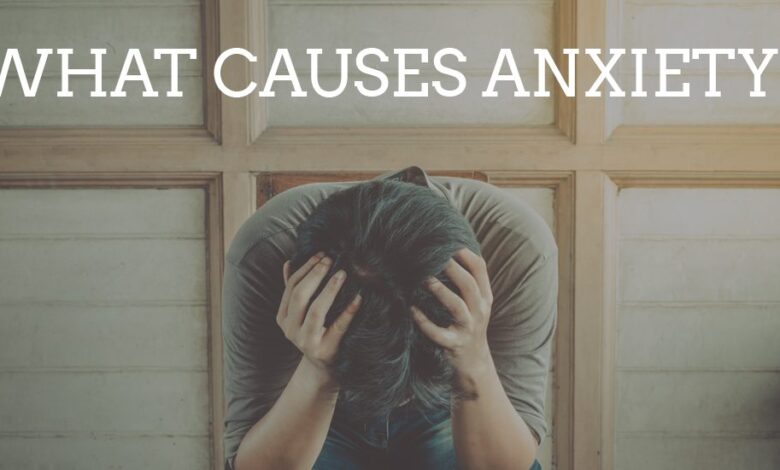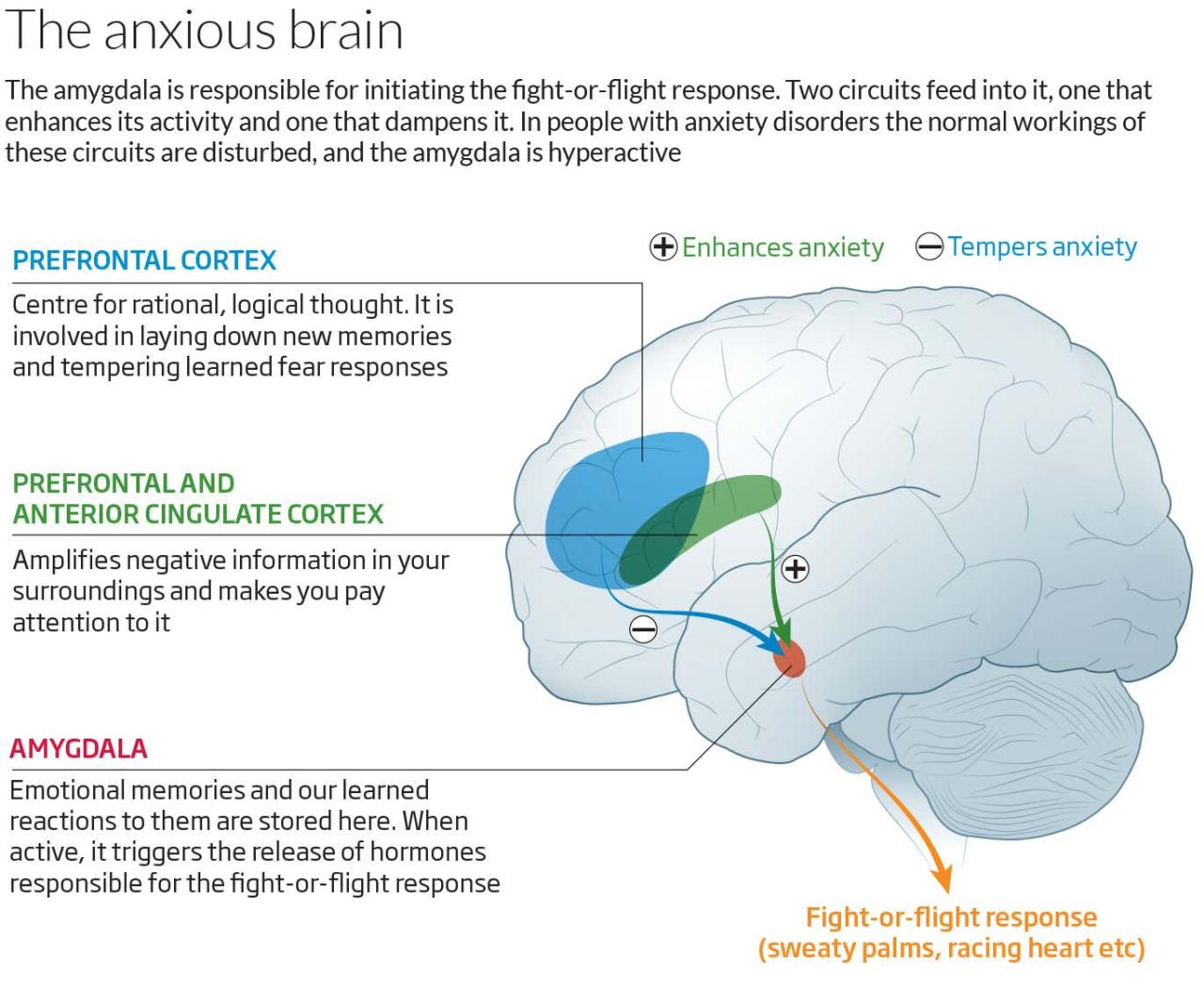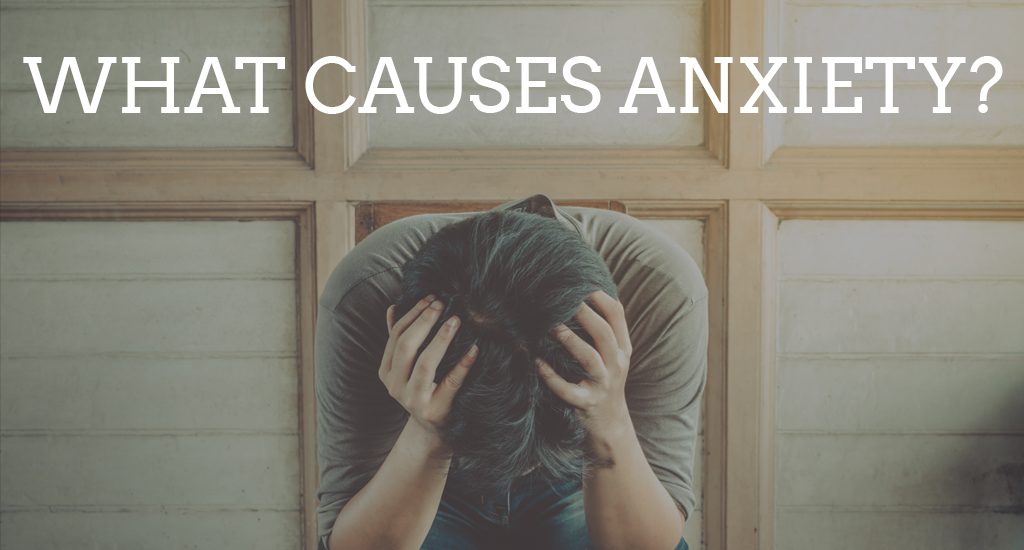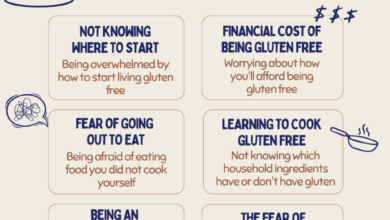
Why stress and anxiety arent always bad for you – Why stress and anxiety aren’t always bad for you. This exploration delves into the surprising ways that short-term stress can boost performance, and how moderate anxiety can sharpen focus. We’ll examine the body’s natural responses, highlighting the adaptive aspects of these feelings. Beyond the physiological, we’ll uncover how stress can motivate us, promote preparation, and even drive personal growth.
From competitive environments to high-pressure situations, we’ll investigate how stress and anxiety can be crucial catalysts for creativity and overcoming challenges. We’ll also look at how different demographics experience stress and anxiety, considering factors like age, culture, and socioeconomic status. Ultimately, we’ll distinguish between healthy and unhealthy stress responses, exploring the crucial difference between manageable stress and overwhelming anxiety.
Physiological Benefits of Stress and Anxiety

Stress and anxiety, while often perceived negatively, aren’t always detrimental. In fact, moderate levels can trigger positive physiological responses, enhancing performance and resilience. Understanding these benefits can help us better manage our reactions to stress and anxiety, and potentially leverage them for our advantage.The human body is remarkably adaptable. Our physiological responses to stress, both positive and negative, are complex and influenced by factors like the intensity, duration, and individual perception of the stressor.
While chronic, overwhelming stress can lead to serious health issues, short-term stress can be a powerful catalyst for improved physical and mental performance.
Short-Term Stress and Enhanced Physical Performance
Short bursts of stress hormones, like adrenaline and cortisol, prepare the body for physical exertion. This physiological response, often referred to as the “fight-or-flight” response, increases heart rate, blood flow, and muscle strength, enabling a temporary surge in performance. Athletes often utilize this phenomenon to improve their performance during high-intensity activities.
Moderate Anxiety and Sharpened Cognitive Function
Moderate anxiety can heighten focus and concentration. The increased alertness and heightened awareness associated with moderate anxiety can enhance cognitive function and memory recall. This is often observed in situations requiring quick thinking and problem-solving. For example, students often report feeling a degree of anxiety that enhances their ability to concentrate during exams.
The Body’s Adaptive Responses to Stress and Anxiety
The body’s response to stress and anxiety is an adaptive mechanism. The release of hormones like adrenaline and cortisol primes the body for immediate action. These hormones increase heart rate, blood flow, and energy levels. This heightened state is crucial for facing perceived threats.
Stress and Anxiety’s Influence on the Immune System
In short bursts, stress and anxiety can actually boost the immune system. The release of certain cytokines, immune system proteins, can strengthen the body’s defense against pathogens. However, prolonged or excessive stress can weaken the immune response.
Physiological Responses to Varying Stress Levels
| Stress Level | Physiological Responses | Impact |
|---|---|---|
| Low (eustress) | Increased alertness, improved focus, enhanced immune response | Positive |
| Moderate | Increased heart rate, blood flow, muscle strength, heightened awareness, improved memory recall | Positive (short-term) |
| High (distress) | Chronic activation of stress response, suppressed immune function, increased risk of cardiovascular issues | Negative (long-term) |
| Extreme | Panic attacks, severe anxiety, potential for mental and physical health crises | Negative (immediate and long-term) |
Motivational and Behavioral Impacts: Why Stress And Anxiety Arent Always Bad For You
Stress and anxiety, while often perceived negatively, can surprisingly play a crucial role in motivating and shaping our behaviors. Understanding how these emotions impact our drive to achieve goals and prepare for challenges is key to navigating them effectively. This section delves into the motivational and behavioral impacts of stress and anxiety, exploring how these feelings can be both a catalyst and a warning signal.While the immediate reaction to stress and anxiety is often one of avoidance or discomfort, a closer examination reveals a complex interplay between these emotions and our actions.
Sometimes, these feelings can push us to perform better, prepare more thoroughly, and ultimately, foster personal growth. The key lies in recognizing the difference between healthy, acute stress and the detrimental effects of chronic stress.
Stress as a Motivator
Stress, in its acute form, can act as a powerful motivator, pushing us to perform at our peak. This is often seen in situations requiring quick action or high concentration, such as during a crucial exam or a sporting event. The physiological response to stress, characterized by increased adrenaline and focus, can heighten awareness and sharpen cognitive abilities.
This temporary surge in stress hormones can lead to increased productivity and enhanced performance. For example, a student facing an impending exam might experience stress, but this stress can lead to focused study sessions and better exam results.
Sometimes, a little stress or anxiety can actually be a good thing, acting as a motivator or a warning sign. It’s all about the balance, right? For instance, if you’re facing a sudden, unexpected medical event like a heart attack, knowing CPR could be a lifesaver. Learning CPR for heart attack shows you’re prepared to handle potentially life-threatening situations.
Ultimately, recognizing stress and anxiety as sometimes helpful, while also acknowledging when it’s time to seek help, is key to managing your well-being.
Anxiety and Preparation
Anxiety, while often associated with negative experiences, can also serve as a crucial signal to prepare for potential threats or challenges. This anticipatory anxiety can prompt individuals to meticulously plan and prepare, creating a sense of readiness and control. For example, a person anticipating a job interview might experience anxiety, but this anxiety could motivate them to rehearse their answers and research the company, leading to a more confident and successful interview.
Stress and Anxiety Driving Personal Growth
Both stress and anxiety, when managed constructively, can foster personal growth. Facing and overcoming challenges related to stress or anxiety can lead to a deeper understanding of oneself and one’s limits. Learning to cope with stressful situations and manage anxiety can equip individuals with valuable coping mechanisms and resilience, enabling them to handle future challenges with greater ease.
Overcoming a fear of public speaking, for example, through gradual exposure and practice, can result in significant personal growth and improved confidence.
Acute vs. Chronic Stress on Motivation
Acute stress, as mentioned earlier, can be a powerful motivator, leading to focused effort and heightened performance. However, chronic stress, characterized by prolonged exposure to stressors, can diminish motivation and lead to burnout. Chronic stress can create a sense of overwhelm and hopelessness, hindering the ability to focus on goals and reducing the drive to achieve them. The difference lies in the duration and intensity of the stressor.
Types of Stressors and Motivational Effects
| Type of Stressor | Motivational Effect (Potential) |
|---|---|
| Academic Pressure | Can motivate students to study harder and perform better, but chronic pressure can lead to burnout and decreased motivation. |
| Financial Strain | Can motivate individuals to find ways to earn more income, save more, or find creative solutions to financial problems. Chronic financial strain can lead to anxiety and hopelessness, hindering motivation. |
| Relationship Conflicts | Can motivate individuals to communicate better, work on resolving conflicts, or seek support. Chronic relationship conflicts can lead to emotional exhaustion and diminished motivation. |
| Work Deadlines | Can motivate individuals to prioritize tasks and meet deadlines, but overwhelming deadlines can lead to procrastination and decreased productivity. |
| Health Concerns | Can motivate individuals to adopt healthier lifestyle choices, seek medical attention, and prioritize well-being. Chronic health concerns can lead to feelings of helplessness and decreased motivation. |
This table illustrates how different stressors can potentially impact motivation. The crucial element is the duration and intensity of the stressor. Acute stressors can be powerful motivators, while chronic stressors can lead to the opposite effect.
Adaptive Responses and Coping Mechanisms
Stress and anxiety, while sometimes perceived negatively, can also be catalysts for personal growth and resilience. Developing adaptive responses and effective coping mechanisms is crucial in navigating these experiences constructively. This involves recognizing the triggers, understanding the physiological reactions, and actively employing strategies to manage the associated emotions.
Sometimes, stress and anxiety aren’t all bad. They can be signals that something needs attention, like the difficulties of managing a demanding job with multiple sclerosis. Navigating those challenges requires significant mental fortitude, and that often involves coping mechanisms that, while stressful, ultimately help you adapt. It’s about finding healthy ways to manage the stress, and recognizing that even these challenges can be stepping stones to a more resilient you.
Ultimately, stress and anxiety can be valuable motivators for change and personal growth, even if it’s the difficulties of your job with multiple sclerosis that highlight that need.
Developing Adaptive Responses
Individuals develop adaptive responses to stress and anxiety through repeated exposure and learning. Over time, individuals learn to identify the specific stressors that elicit these responses. This awareness allows them to anticipate potential triggers and proactively implement coping strategies. They refine their responses based on past experiences, adjusting their approach based on what worked and what didn’t. This process of trial and error and adaptation is key to long-term management.
Coping Strategies for Transforming Stress
Effective coping strategies can transform stress into a positive experience. These strategies aim to manage the physiological and emotional responses to stress, allowing individuals to channel the energy into productive action. Healthy coping mechanisms are crucial in preventing stress from becoming overwhelming.
Learning to Manage Anxiety Effectively
Learning to manage anxiety effectively involves recognizing and challenging negative thought patterns. Identifying and understanding the underlying causes of anxiety is paramount. Cognitive restructuring techniques, such as reframing negative thoughts into more positive and realistic ones, are often employed. Regular practice of relaxation techniques, such as deep breathing or mindfulness exercises, can significantly reduce anxiety levels. Professional guidance from therapists or counselors can also be immensely helpful in developing and implementing these strategies.
Coping Mechanisms and Effectiveness
| Coping Mechanism | Effectiveness in Different Situations |
|---|---|
| Exercise | Excellent for reducing physical tension and improving mood. Particularly effective for managing stress related to physical demands or deadlines. |
| Mindfulness Meditation | Helpful for managing stress and anxiety related to intrusive thoughts and racing minds. Particularly effective for improving focus and reducing rumination. |
| Journaling | Effective for processing emotions and identifying patterns. Particularly useful for stress stemming from personal challenges or relationship conflicts. |
| Time Management | Helpful in reducing stress related to overwhelming workloads or deadlines. Effective for situations requiring organization and prioritization. |
| Social Support | Crucial for providing perspective and emotional support during stressful periods. Particularly effective for navigating challenging social situations or personal crises. |
| Problem-Solving | Focuses on addressing the root cause of stress directly. Effective in situations where a specific issue or challenge is causing the stress. |
Healthy Lifestyle Choices in Stress Management
Maintaining a healthy lifestyle is fundamental to managing stress and anxiety. Adequate sleep, balanced nutrition, and regular physical activity play vital roles in reducing stress hormones and boosting the body’s resilience. Avoiding excessive caffeine or alcohol intake can also help regulate mood and reduce anxiety. Furthermore, cultivating a supportive social network and engaging in hobbies or activities that bring joy and relaxation are crucial for maintaining overall well-being.
These healthy lifestyle choices create a strong foundation for coping with stress and anxiety more effectively.
Stress and Anxiety in Specific Contexts
Stress and anxiety, while often viewed as detrimental, can actually play a crucial role in various contexts. Understanding how these emotions manifest and contribute to specific situations can help us navigate them more effectively. This section delves into the positive aspects of stress and anxiety in competitive environments, creative endeavors, high-pressure situations, and personal growth.Stress, when managed properly, can be a powerful motivator.
It primes our bodies for action and enhances our focus. Anxiety, in moderate levels, can sharpen our senses and make us more alert, which is vital in certain situations.
Stress in Competitive Environments
Competitive environments, whether academic, professional, or athletic, often necessitate a certain level of stress. This stress can act as a catalyst for improved performance. The pressure to succeed can drive individuals to push their boundaries and strive for excellence. For example, a student facing a challenging exam might experience stress, but this stress can fuel their preparation and ultimately lead to a higher score.
Similarly, an athlete under pressure in a crucial game might perform beyond their perceived limitations due to the heightened physiological arousal.
Sometimes, a little stress and anxiety can actually be helpful! It’s all about finding the right balance, and a good night’s sleep plays a crucial role. Investing in a comfortable mattress, like a Stearns and Foster mattress , can significantly improve your sleep quality. This, in turn, can help regulate your stress hormones and keep those anxiety levels manageable, showing that even the seemingly negative emotions aren’t always detrimental.
Anxiety as a Catalyst for Creativity
Anxiety, though often associated with discomfort, can surprisingly be a wellspring for creativity. The heightened awareness and focus that anxiety produces can lead to innovative solutions and unique perspectives. For instance, a writer experiencing a creative block might find that a moderate level of anxiety can spark a surge of ideas, prompting them to explore new themes and approaches to their work.
The pressure to produce something meaningful can lead to breakthroughs.
Stress and Anxiety in High-Pressure Situations, Why stress and anxiety arent always bad for you
High-pressure situations, such as emergencies or high-stakes performances, require immediate responses and quick thinking. Stress and anxiety, in these contexts, can act as crucial triggers for rapid reaction and heightened awareness. This heightened awareness and focus enable individuals to make critical decisions and perform optimally under duress. For example, a firefighter facing a blaze or a surgeon performing a complex operation experiences stress and anxiety, but these emotions allow them to act swiftly and effectively.
Stress and Anxiety as Drivers for Overcoming Challenges
Stress and anxiety, while uncomfortable, can also serve as powerful motivators for overcoming personal challenges. The discomfort associated with stress can spur individuals to take action, to learn new skills, and to adapt to difficult situations. For instance, an individual facing a significant career change might experience anxiety, but this anxiety can drive them to acquire new skills, network with others, and ultimately succeed in their new endeavor.
The stress of facing an obstacle can prompt an individual to develop resilience.
Table: Situations Where Stress and Anxiety Are Not Necessarily Detrimental
| Situation | Specific Example | Positive Impact of Stress/Anxiety |
|---|---|---|
| Competitive Exams | Preparing for a crucial final exam | Increased focus and motivation |
| High-Stakes Performances | Giving a presentation to a large audience | Enhanced alertness and performance |
| Emergencies | Responding to a sudden medical emergency | Quick reaction and effective decision-making |
| Creative Processes | Writing a novel | Heightened awareness and unique perspectives |
| Personal Growth | Facing a major life transition | Motivation to adapt and learn new skills |
Distinguishing Between Healthy and Unhealthy Stress/Anxiety
Stress and anxiety are normal human responses to challenges. While often perceived negatively, moderate levels can actually be beneficial, motivating us to adapt and overcome obstacles. However, when stress and anxiety become overwhelming, they can significantly impair our well-being. This section delves into the crucial distinction between healthy and unhealthy responses to stress and anxiety, helping you identify the signs of when to seek support.Understanding the nuances of stress and anxiety is key to navigating life’s complexities effectively.
Identifying the specific triggers and characteristics of our reactions allows us to develop personalized strategies for managing these emotions. This, in turn, allows us to transform potentially harmful responses into helpful coping mechanisms.
Healthy vs. Unhealthy Stress Responses
Differentiating between healthy and unhealthy stress responses involves recognizing the intensity, duration, and impact of the stressor. Healthy stress is typically brief and manageable, prompting adaptive responses that enhance performance and well-being. Unhealthy stress, on the other hand, is prolonged, overwhelming, and can lead to detrimental physical and mental consequences.
Characteristics of Manageable vs. Overwhelming Stress
Manageable stress is characterized by a temporary increase in heart rate, mild muscle tension, and a heightened sense of focus. It often leads to increased productivity and problem-solving skills. Overwhelming stress, in contrast, involves persistent feelings of anxiety, panic, and overwhelm, often accompanied by physical symptoms like headaches, digestive issues, and sleep disturbances. The key difference lies in the duration and intensity of the response.
Acute vs. Chronic Stress: Helpful vs. Harmful Responses
Acute stress is a short-term response to a specific event, like a deadline or a presentation. A helpful acute stress response might involve increased alertness and focus, enabling successful completion of the task. However, an unhealthy response might manifest as extreme panic and disorganization, hindering performance. Chronic stress, on the other hand, is persistent and long-lasting, stemming from ongoing pressures like financial difficulties or relationship issues.
A helpful response to chronic stress involves adopting effective coping mechanisms and seeking support. A harmful response, conversely, might lead to burnout, depression, and other health problems.
Signs of Excessive Anxiety
Excessive anxiety is characterized by persistent worry, fear, and apprehension, often interfering with daily activities. These anxieties may manifest as physical symptoms, such as trembling, rapid heartbeat, shortness of breath, or nausea. Furthermore, it can significantly impact cognitive functions, causing difficulties in concentration, memory, and decision-making. Distinguishing between normal worry and excessive anxiety requires understanding the intensity and pervasiveness of the symptoms.
Excessive anxiety frequently leads to avoidance behaviors and a sense of being trapped in a cycle of worry.
Negative Consequences of Prolonged or Intense Stress and Anxiety
Prolonged or intense stress and anxiety can have a cascade of negative consequences. These include physical health problems like cardiovascular issues, weakened immune systems, and gastrointestinal problems. Mentally, it can lead to depression, anxiety disorders, and sleep disturbances. Socially, it can impact relationships and cause isolation. Identifying and addressing the root causes of stress and anxiety are crucial to preventing these detrimental outcomes.
Recognizing these signs and seeking appropriate help is essential to preventing long-term damage.
Stress and Anxiety in Specific Demographics

Stress and anxiety aren’t monolithic experiences; they manifest differently across various demographic groups. Understanding these variations is crucial for developing effective support strategies and interventions tailored to specific needs. This section delves into how factors like age, culture, socioeconomic status, and gender shape the experience and expression of stress and anxiety.
Age-Related Differences
Stress and anxiety can affect individuals of different ages in unique ways. Children, for instance, may experience stress related to academic pressure, bullying, or family issues, manifesting as behavioral problems, sleep disturbances, or somatic complaints. Teenagers face the added pressures of identity formation, social acceptance, and future uncertainties, potentially leading to anxiety disorders like generalized anxiety disorder or social anxiety.
Adults may experience stress related to career demands, relationship challenges, or financial concerns, often manifesting as burnout, depression, or panic attacks. Older adults might face stress due to health concerns, loss of independence, or the death of loved ones, leading to increased vulnerability to mental health issues.
Cultural Influences on Stress Responses
Cultural backgrounds significantly influence how individuals perceive, experience, and express stress and anxiety. For example, some cultures may encourage open expression of emotions, while others emphasize stoicism and emotional restraint. These cultural norms can impact how individuals cope with stress and seek help. Furthermore, cultural stressors, like discrimination or immigration challenges, can contribute to higher levels of stress and anxiety.
Understanding these nuances is essential to develop culturally sensitive interventions.
Socioeconomic Impact on Stress and Anxiety
Socioeconomic factors play a crucial role in shaping stress and anxiety levels. Individuals from lower socioeconomic backgrounds often face greater financial instability, limited access to resources, and exposure to social stressors, such as poverty and crime. These factors can lead to chronic stress and an increased risk of developing mental health conditions. Conversely, individuals from higher socioeconomic backgrounds may face pressure to maintain a certain lifestyle or achieve specific goals, leading to different types of stress.
Gender Variations in Stress and Anxiety
Gender differences can influence the types of stressors experienced and the ways in which stress and anxiety are expressed. Women, for instance, may experience stress related to gender inequality, discrimination, or caregiving responsibilities, while men may face stress associated with societal expectations of masculinity or career pressures. Research suggests that women may be more prone to experiencing anxiety disorders, while men may be more likely to experience stress-related physical health problems.
It is important to note that these are generalizations and individual experiences vary widely.
Demographic Manifestations of Stress and Anxiety
| Demographic Group | Potential Stressors | Potential Manifestations |
|---|---|---|
| Children (ages 6-12) | Academic pressure, bullying, family conflict | Behavioral problems, sleep disturbances, somatic complaints |
| Teenagers (ages 13-19) | Identity formation, social acceptance, future uncertainty | Anxiety disorders, depression, substance abuse |
| Young Adults (20-30s) | Career transitions, relationship challenges, financial instability | Burnout, depression, relationship conflicts |
| Middle-Aged Adults (40-50s) | Career pressures, family responsibilities, health concerns | Stress-related illnesses, burnout, depression |
| Older Adults (65+) | Health concerns, loss of independence, death of loved ones | Increased vulnerability to mental health issues, depression, loneliness |
| Low Socioeconomic Status | Poverty, limited access to resources, social stressors | Chronic stress, increased risk of mental health conditions |
| Women | Gender inequality, discrimination, caregiving responsibilities | Increased risk of anxiety disorders, stress-related physical health problems |
| Men | Societal expectations of masculinity, career pressures | Increased risk of stress-related physical health problems, difficulties expressing emotions |
| Specific Cultures | Cultural stressors, discrimination, immigration challenges | Different coping mechanisms, varying expressions of stress and anxiety |
Closing Summary
In conclusion, while prolonged or intense stress and anxiety can be detrimental, short-term stress and moderate anxiety often play surprisingly positive roles in our lives. Understanding the physiological, motivational, and adaptive aspects of these responses can empower us to manage them effectively and harness their potential for growth. By recognizing the difference between healthy and unhealthy stress, we can navigate these complex emotions with greater clarity and control.




